
Owning pets brings warmth, companionship, and joy to a home—but it also introduces a unique set of maintenance challenges that can quietly affect your home’s condition over time. From additional moisture in the air to scratches on flooring, pet-related wear and tear can accumulate quickly if not managed properly. Staying proactive with a few key upkeep tasks can help preserve your home’s value, appearance, and comfort.
1. Flooring Care and Protection
Floors take the brunt of pet activity. Claws, accidents, and tracked-in debris can cause long-term damage if left unchecked. Regular vacuuming or sweeping—especially near entryways and feeding areas—prevents grit from scratching hard surfaces. If you have hardwood, consider applying a protective finish every few years to maintain its resilience. For carpeted areas, professional deep cleaning twice a year helps control pet odors and stains while extending the carpet’s lifespan. Area rugs near doors or high-traffic spots can also serve as a protective buffer.
2. Managing Pet Odors and Air Quality
Pets shed dander, fur, and oils that can settle into fabrics and circulate through your HVAC system. Changing air filters every 30 to 60 days (instead of the typical 90) significantly improves air quality. It’s also worthwhile to schedule annual duct cleaning if you have heavy-shedding animals. Wash pet bedding weekly and use washable slipcovers on furniture where pets like to rest. For persistent odors, a dehumidifier can help regulate indoor moisture—keeping your home fresher and less inviting to mold or mildew.
3. Wall and Trim Maintenance
Over time, walls, baseboards, and trim can collect marks from wagging tails or muddy paws. Semi-gloss or satin paint finishes are easier to wipe clean than flat paints and resist staining. It’s smart to inspect lower wall sections periodically for paint wear or moisture buildup, particularly near pet water bowls or litter boxes. Touching up these areas early prevents more visible or expensive repairs later.
4. Exterior and Yard Considerations
Pets can also impact your home’s exterior. Dogs, for instance, often create well-worn paths or dig spots along fences and foundations. Inspect these areas for erosion or gaps that might allow pests or moisture intrusion. Secure fences and gates to ensure both safety and structural stability. In yards, pick up waste regularly—beyond sanitation, this helps protect lawns from nitrogen burns and reduces fly attraction.
5. Plumbing and Water Damage Prevention
Frequent pet baths or spilled water bowls can lead to unnoticed leaks or dampness around tubs, sinks, or laundry areas. Inspect caulking and grout annually, resealing where necessary to prevent water seepage. Under sinks, check for pet food or water containers that might trap moisture or cause slow leaks to go undetected.
Caring for pets and maintaining a home don’t have to be competing priorities. By weaving a few pet-conscious habits into your regular maintenance routine, you can enjoy a cleaner, healthier living space—one that keeps both your home and your four-legged companions happy for years to come.
